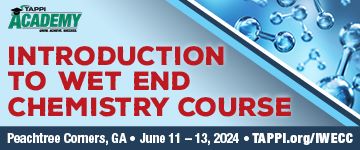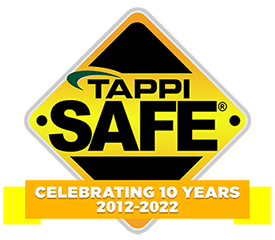 Search
Search
Use the search bar or filters below to find any TAPPI product or publication.
Filters
Content Type
Publications
Level of Knowledge
Collections
Journal articles

Magazine articles

The Influence of the Fine Structure of Cellulose on the Action of Cellulases, TAPPI Journal June 2022
ABSTRACT: In the hydrolysis of cellulose with enzymes of Aspergillus niger at 47°C., it shown that a great decrease in the rate occurred in the late stage of the reaction, usually with considerable cellulose still reamaining undissolved.
Journal articles

Magazine articles

Effects of rings on flow and temperature in lime kilns, TAPPI Journal June 2022
ABSTRACT: A steady state, two-dimensional (2D) axisymmetric model has been developed to help understand how rings form and grow in a typical lime kiln. Rings of varying length, thickness, and geometry at the front and back faces were modeled to study the effects on flue gas flow and temperature. The results show that ring growth causes the gas velocity to increase and insulates the adjacent refractory, resulting in a lower kiln shell temperature. The results also reveal the formation of recirculation zones immediately down-stream of the rings, as well as temperature deviations upstream and downstream of the rings that might promote recarbonation and further ring growth. The model was applied to a kiln from a kraft mill with front-end and mid-kiln rings and good agreement was obtained between the measured and predicted kiln shell temperatures, providing confidence in the modeling.
Journal articles

Magazine articles

Influence of pallet pattern on top-to-bottom compression performance of unitized loads, TAPPI Journal November 2021
ABSTRACT: Environmental scaling factors estimate a corrugated container’s ability to withstand various conditions it will encounter during the storage and distribution process. In this project, we examined the compressive resistance of unitized loads using differing pallet stacking patterns. To simulate real-world failure scenarios in our laboratory tests, we used two different nominal board grades of single-wall C-flute regular slotted containers loaded with a plywood panel and bagged salt to direct the failure location to the bottom of the stack. Our results showed that the columnar aligned pattern provided the greatest compressive resistance and the interlocked stacking arrangement yielded the lowest of the patterns evaluated. Based on the study results, we calculated box compression retention multipliers for each pattern and compared them to scaling factors published by the Fibre Box Association.
Journal articles

Magazine articles

Microbial load and proliferation associated with various face mask types and sources during the COVID-19 pandemic, TAPPI Journal January 2022
ABSTRACT: Due to the shortage of personal protective equipment during the COVID-19 pandemic, homemade face coverings were recommended as alternatives. However, the capability of alternative face coverings to proliferate microbes have not been fully documented. The current study evaluated bacterial load and proliferation associated with the use of common face masks during the COVID-19 pandemic. Mask type-specific and surface-related bacterial load and pattern were noticeable in the study. Results indicated that roadside masks are among samples that contained relatively higher initial bacterial load. The highest number of bacterial forming colonies were observed in the inner surface of mask samples. Proliferation of microbes over time was also noticeable among the non-certified face coverings included in the study. Sterilization or washing of non-certified fabric face masks before use is recommended.
Journal articles

Magazine articles

Editorial: TAPPI Journal Best Research Paper for 2023 focuses on black liquor concentration using graphene oxide membranes, TAPPI Journal February 2024
ABSTRACT: TAPPI and the TAPPI Journal (TJ) Editorial Board would like congratulate the authors of the 2023 TAPPI Journal Best Research Paper Award and Honghi Tran Prize: Sam Rae, Ella V. Richards, Max Kleiman-Lynch, Brent D. Keller, and Brandon I. Macdonald. Their paper, “Pilot scale black liquor concentration using pressure driven membrane separation,” appeared on p. 223 of the April 2023 issue. This kraft recovery cycle research was recognized by the TAPPI Journal Editorial Board for its innovation, creativity, scientific merit, and clear expression of ideas.
Journal articles

Magazine articles

Effect of pressure and time on water absorption of coated paperboard based on a modified Cobb test method, TAPPI Journal April 2024
ABSTRACT: This manuscript presents the study of water absorption by paperboard subjected to water at high hydrostatic pressure based on a modified Cobb tester. The new tester is based on TAPPI Standard Test Method T 441; however, the water column can reach up to 550 mm. The evaluation consisted of measurements of water absorption for coated and uncoated paperboard at different exposure times from 5 s to 45 s and water column heights from 10 mm to 500 mm (corresponding to hydrostatic pressures 98 Pa and 4.9 kPa, respectively). The coatings were formulated as a combination of styrene acrylate (SA; two binder levels) and two types of ground calcium carbonates (differing particle sizes) to form the two pre-coating structures: open and closed. The coating weight was 6 g/m2 applied on 210 g/m2 solid bleached board (SBB). In addition, 210 g/m2 uncoated boards were studied. Characterization of the coatings was performed with scanning electron microscopy (SEM), mercury intrusion, and roughness. It was found that the new device properly mimics the conditions of the current Cobb tester. The characterization of the coating also confirmed the presence of more open/larger pores of open coatings, confirming the desired coating structure. The absorption of boards was mainly driven by exposure pressure by comparing with exposure time. This was already evident after shorter periods of exposure time at 5 s and also 15 s exposure time. Paperboards with open coatings showed slightly higher absorption than other boards.
Journal articles

Magazine articles

Web instability in the open draw and the impact on paper machine efficiency, TAPPI Journal May 2022
ABSTRACT: Paper is most likely to break in the first open draw on a paper machine where it is unsupported, wettest, and weakest. Tension is applied to peel the web from the roll surface, as well as minimize web flutter in the open draw. The average tension is well below the breaking point and is often set by adjusting the speed difference between the press and the next machine element by visually observing the behavior of the web. However, machine direction variations caused by instabilities in the paper machine can cause tension swings that exceed the strength of the web. Measurement of the web’s release point from press rolls on pilot and commercial paper machines was used to identify the cause of tension instabilities. Variations in the speed of the paper machine drives and the work of adhesion from the press roll surface were identified as key factors. Fluctuations of paper moisture, which affects the elastic modulus and strength of the web, appear to be less important.
Journal articles

Magazine articles

Compression refining: the future of refining? Application to Nordic bleached softwood kraft pulp, TAPPI Journal August 2024
ABSTRACT: A new compression refining technology based on the kneading of high consistency pulp has been selected and tested in various conditions with a model Nordic bleached softwood kraft (NBSK) pulp. The method uses a kneader mixer referred to as the ultra continuous mixer (UCM) to condition the pulp. Its performance levels were also compared with those obtained with traditional low consistency (LC) refining of the same pulp.Compression refining of the NBSK pulp with the UCM led to a much better °SR/strength compromise than conventional LC refining. High strength properties can also be achieved by compression refining, in a range similar to/or better than LC refining. The higher the strength required, the greater the advantages of this technology: for a given strength, a difference of up to 10°SR can be obtained as compared to LC refined pulp. Moreover, a higher tear index can be obtained with compression refining, since fiber cutting is greatly reduced.The lower °SR is due to the release of fewer cellulosic fines, which also results in the manufacturing of new papers combining a high strength and a high permeability that cannot be obtained with traditional LC refining. Indeed, with LC refining, a high strength is generally associated with a low permeability. Upscaling this technology seems to be possible since large production devices are already on the market for applications other than paper/pulp. With this new pulp behavior, papermakers will have to learn to think differently, as paper strength and °SR can now be decorrelated.
Journal articles

Magazine articles

Convolutional neural networks enhance pyrolysis gas chromatography mass spectrometry identification of coated papers, TAPPI Journal August 2024
ABSTRACT: In the evolving paper industry, accurate identification of coated paper components is essential for sustainability and recycling efforts. This study employed pyrolysis-gas chromatography mass spectrometry (Py-GCMS) to examine six types of coated paper. A key finding was the minimal interference of the paper substrate with the pyrolysis products of the coatings, ensuring reliable analysis. A one-dimensional convolutional neural network (1D-CNN) was employed to process the extracted ion chromatograms directly, simplifying the workflow and achieving a predictive accuracy of 95.2% in identifying different coating compositions. Additionally, the study high-lighted the importance of selecting an optimal pyrolysis temperature for effective feature extraction in machine learning models. Specific markers for coated papers, including polyethylene (PE), polypropylene (PP), polyethylene terephthalate (PET), polybutylene succinate (PBS), polylactic acid (PLA), and waterborne polyacrylates (WP), were identified. This research demonstrates a novel approach to coated paper identification by combining Py-GCMS with machine learning, offering a foundation for further studies in product quality and environmental impact.
Journal articles

Magazine articles

Comparative study of guar gum and its cationic derivatives as pre-flocculating polymers for PCC fillers in papermaking applications, TAPPI Journal April 2022
ABSTRACT: In this work, gums from guar seeds were evaluated as a potential precipitated calcium carbonate (PCC) filler pre-flocculant to induce functional filler in papermaking applications. In recent years, guar has been conidered one of the promising wet-end additives due to its abundance, rich source of hemicellulose content, and bio-degradability. However, application of guar gum in filler pretreatment methods for producing high ash paper has scarcely been reported. In this paper, the flocculating ability of three types of guar gum was established with charge analysis and turbidity (NTU) of the system at 1% and 5% for each gum: native gum (NG) having a degree of substitution (DS) of 0, and cationic gums having a DS value of 0.07 (CL) and 0.15 (CH). It was interesting to observe that even at a 5% dose of G, the charge density of PCC did not deviate much from the initial values. The system carried a weak negativeharge, resulting in an unstable colloidal suspension that led to PCC-PCC particle bridging. On the other hand, the operative mechanism of CL and CH during adsorption and PCC flocculation was predicted to be charge neutralization and electrostatic-patch formation, accompanied by particle bridging. Note that CL, with a maximum 47.5% eduction in residual turbidity of PCC at a 1% dose, was much more efficient in doing so than the other two gums; NG had a 40% maximum reduction in residual turbidity at a 5% dose and CH had a maximum 30% reduction at a 1% ose. Later on, floc formation and structure were correlated with optical and field emission scanning electron microscopy (FE-SEM) images. In the next set of trials, paper properties were determined by varying the different gum dosages from 0.2% to 5% at a constant dose of 20% filler. It is also noteworthy to mention that with 1% CL (low DS) dose, PCC retention increased by 39%, which also enhanced the tensile, tear, burst, and opacity properties by 11%, 19%, 5%, and 4.4%, respectively, without significantly affecting the bulk properties. Further, wide-angle X-ray diffraction (XRD) analysis nd Fourier transform infrared (FTIR) analysis revealed that pre-flocculating PCC with a 1% gum dose did not induce any change in crystalline transformation. Based on observation, it was found that cationic gums with low DS values re a better choice for maximizing the strength of paper while maintaining bulk and high opacity when pre-flocculaion is adopted to increase the filler retention in paper.






